























Publisher Shelly Spence
Managing Editor
Joseph J. Airdo
Graphic Designer
Meaghan Mitchell
Contributing Writers
Joseph J. Airdo
Francine Coles
Shannon Severson
Photographers
Francine Coles
Loralei Lazurek
Advertising Sales
Cindi Calcinari
860-966-3271 cindi@imagesaz.com
Images Arizona P.O. Box 1416 Carefree, AZ. 85377 623-341-8221 imagesarizona.com
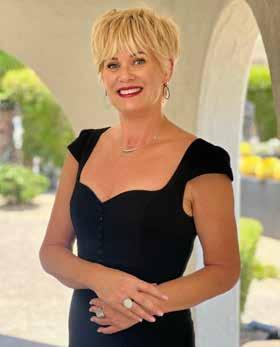
AAs the summer heat lingers in Arizona, many of us find ourselves daydreaming of faraway destinations and exotic locales. In this special summer edition of Images Arizona, we’ve curated a collection of stories that celebrate the rich tapestry of international cultures thriving in our sunsoaked landscape.
Our adventure begins close to home as we commemorate Carefree’s 40th anniversary. From there, we embark on a colorful exploration of Arizona’s diverse communities, from African drum circles to Dutch King’s Day celebrations, revealing how these vibrant cultures have transformed our Southwest into a rich cultural mosaic.
We also shine a spotlight on Phoenix Sister Cities, an initiative fostering international friendship through youth exchanges and cultural programs and take your taste buds on a tour of the Valley’s best international restaurants, from French Riviera-inspired dishes to authentic Thai flavors and rustic Italian fare.
Finally, prepare to have your perceptions challenged as photographer Kelly Hahs reveals Arizona’s hidden oases and dramatic landscapes that rival exotic international destinations. To bring a taste of our global journey into your own kitchen, we’ve also included a vibrant Middle Eastern-inspired recipe that’s perfect for summer gatherings.
Whether it’s trying a new international restaurant, attending a cultural festival or simply striking up a conversation with a neighbor from a different background, there are countless ways to broaden our horizons without boarding a plane. So grab your metaphorical passport, and let Images Arizona be your guide to the global wonders waiting to be discovered in our own backyard.
Happy exploring!
Shelly Spence Publisher, Images Arizona magazine
shelly@imagesaz.com 623-341-8221



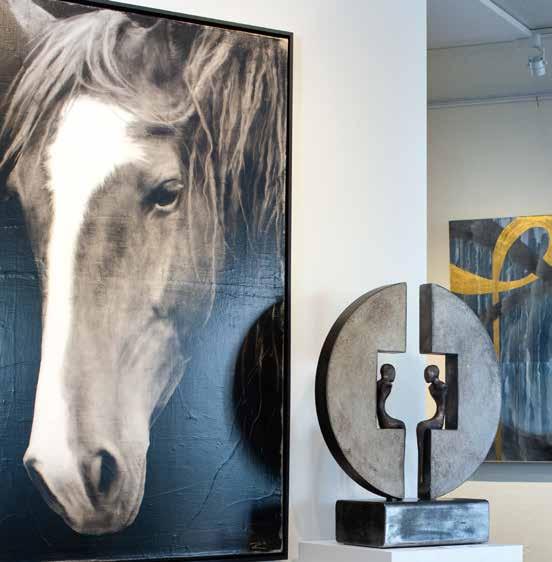

FForty years ago, two visionaries turned a goat farm into a desert utopia. Now, Carefree — a town that lives up to its name — is celebrating its ruby anniversary with the same whimsical spirit that inspired its unique street signs, preserved its dark, starry nights and fostered a community as resilient as the saguaros dotting its landscape.
As the town prepares to mark four decades since its incorporation, residents and visitors alike are invited to join in a series of celebrations that promise to be as unique and captivating as Carefree itself. From movie nights under the stars to a candlelight concert, the festivities offer a perfect blend of nostalgia and forwardlooking optimism.
“The Carefree 40th anniversary celebrations promise to capture our rich history, who we are, and where we are going,” says


The Carefree 40th anniversary celebrations promise to capture our rich history, who we are and where we are going. We may only be 40 years old, but we have a whimsical story, set in beautiful Sonoran Desert surroundings, to tell. Mayor John Crane

Mayor John Crane. “We may only be 40 years old, but we have a whimsical story, set in beautiful Sonoran Desert surroundings, to tell. This year will be fun, and we cannot wait to share it.”
Long before Carefree became an incorporated town, it was a vision in the minds of two enterprising individuals: Tom Darlington and K.T. Palmer. In 1955, they discovered a 400-acre goat farm with an abundant well and secured 2,200 surrounding acres. From this humble beginning, they began to craft their dream of a desert oasis.
Preston Westmoreland, a longtime resident and local historian, paints a vivid picture of those early days.
“K.T. Palmer wrote a book about it, ‘For Land’s Sake,’“ Westmoreland says. “He could stand on that big rock monolith and there’d be nobody within 5 miles. He counted 380 saguaros before he even turned. It was a remarkable place.”
The founders’ vision extended beyond mere development. They sought to create a community that would preserve the natural beauty of the Upper Sonoran Desert while providing a haven for those seeking a quieter, more contemplative




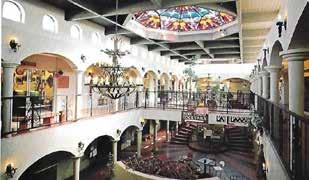
Los Portales Mall was a testament to Carefree's artistic spirit. The centerpiece was a stunning stained-glass ceiling that bathed the atrium in vibrant, colorful light. This architectural marvel, combined with the mall's cool, shaded walkways and unique boutiques, created an inviting atmosphere that perfectly captured the town's blend of Southwestern charm and upscale desert living.
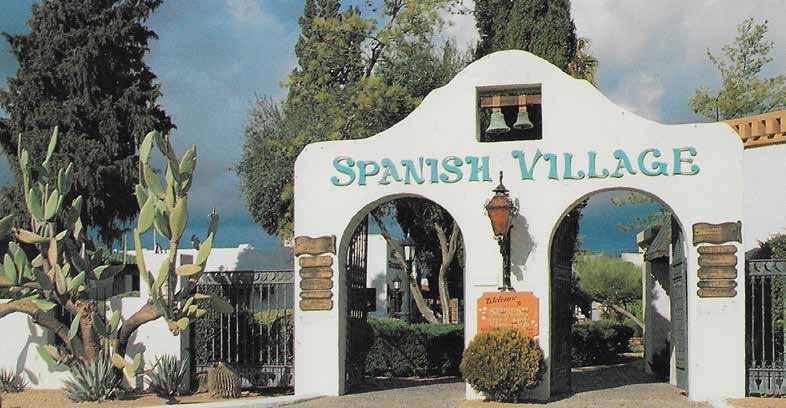
lifestyle. This ethos is reflected in every aspect of the town, from its strict building codes to its commitment to dark skies.
“When we look back and consider our most significant achievements over the past 40 years, I believe the biggest one is that we’ve retained our small-town charm,” Mayor Crane notes. “There have been constant pressures from the outside pushing in on us — things beyond our control, some from the state level, others from our neighbors in Scottsdale and Phoenix. But despite all of that, we’ve managed to maintain our unique charm and character.”
The 40th anniversary celebrations kick off on Aug. 16 with the Historical Happy Hour 5–7 p.m. at Spirit in the Desert. This event promises to be a highlight of the festivities, offering attendees a chance to delve deep into Carefree’s colorful past.
Westmoreland, who will be hosting the event, is particularly excited about one special guest.
“Ruth Palmer, K.T. Palmer’s daughter, is one of the last surviving members of the co-founder of Carefree’s family,” he shares. “I think it’s going to be a really interesting time. My guess is that a lot of people will come out of the woodwork for this event, and we’ll probably be surprised at who shows up.”
Spirit in the Desert, the venue for the Historical Happy Hour, boasts its own intriguing past, adding another layer of historical significance to the event.
“It was originally a 25,000-square-foot international restaurant,” Westmore explains. “That’s as big as a grocery store! It had six different dining rooms you could go to, featuring Nordic, South American, Asian, African, North American and European cuisine. Can you imagine the chef who had to prepare six different types of ethnic food? I can see why it closed down in two years. It was an impossible thing to do.”
The celebrations continue throughout the fall with a series of events designed to appeal to all ages and interests. The town’s Retro Reels series at the Sanderson Lincoln Pavilion will feature films from 1984, the year of Carefree’s incorporation. “Indiana Jones and the Temple of Doom,” “Footloose” and “Gremlins” are all on the docket, offering a nostalgic trip back to the era when Carefree was taking its first steps as an incorporated town.
For those more interested in gazing at the stars than watching them on screen, a family stargazing event is scheduled for Oct. 5 at Our Lady of Joy Church.
“If you look up at the stars, especially on a moonless night, you get quite a show,” Mayor Crane notes. “We want to enhance that experience and reinforce that it’s part of our community.”
Other events include an afternoon of well-being with CIVANA, a fall restaurant week featuring special $40 menus, and a classic car and plane show at Sky Ranch Airport. The celebrations will culminate in a VIP candlelight concert on Dec. 7, promising a magical end to a season of festivities.

Friday, Aug. 16
Historical Happy Hour with Preston Westmoreland // 5–7 p.m. // Spirit in the Desert // 7415 E. Elbow Bend Road, Carefree
Wednesday, Sept. 4
Afternoon of Well-Being with CIVANA // 2–5 p.m. // CIVANA // 37220 Mule Train Road, Carefree
Friday, Sept. 27
Retro Reels: “Indiana Jones and the Temple of Doom” // 7–9 p.m. // Sanderson Lincoln Pavilion // 101 Easy St., Carefree
Sept. 30–Oct. 6
Carefree Fall Restaurant Week // Various locations throughout Carefree
Saturday, Oct. 5
Dark Skies (Family Stargazing Event) // 7–9 p.m. // Our Lady of Joy Church // 36811 N. Pima Road, Carefree
Friday, Oct. 25
Retro Reels: “Footloose” // 7–9 p.m. // Sanderson Lincoln Pavilion // 101 Easy St., Carefree
Saturday, Nov. 9
Wings and Wheels: Classic Cars & Planes // 10 a.m.–2 p.m. // Sky Ranch Airport // 38900 N. School House Road, Carefree
Friday, Nov. 30
Retro Reels: “Gremlins” // 7–9 p.m. // Sanderson Lincoln Pavilion // 101 Easy St., Carefree
Saturday, Dec. 7
VIP Candlelight Concert // 5–8 p.m. // Sanderson Lincoln Pavilion // 101 Easy St., Carefree

Reflecting Carefree's rural character, residents often chose horseback over horsepower for their errands. This scene at the former Valley National Bank, currently a Chase Bank branch, captures the unique blend of modern amenities and Western charm that has defined Carefree since its early days.
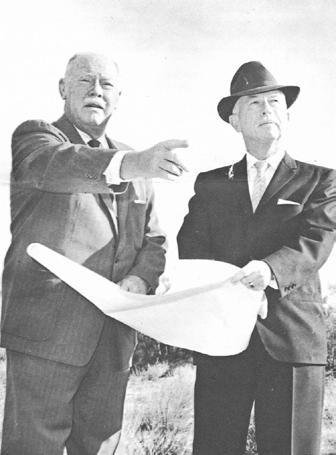
As Carefree celebrates its 40th birthday, it’s worth reflecting on what makes this town so special. For Mayor Crane, it’s the sense of community that sets Carefree apart.
“We have organizations that really tie the community together and reinforce that small-town feel,” he explains. “You’ve got Kiwanis, the Foothills Caring Corps, and the fact that [Desert Foothills Theater] comes up to the Sanderson Lincoln Pavilion in the town center.”
Westmoreland echoes this sentiment.
“Carefree is probably one of the most peaceful places in the world,” he adds. “My wife and I are so glad we moved up here. I never want to live anywhere else. I love to get up and go out my front door to hear wildlife. Sometimes it’s so quiet you can hear the blood rushing in your ears.”
This tranquility, combined with the town’s unique character, has attracted a diverse array of residents over the years, including many notable figures.
“There were so many big, important people in Carefree, but they didn’t want anybody to know they were here,” Westmoreland reveals. “I heard it was the largest collection of CEOs and company owners in America per capita. Every house has a story here as you go down the street.”
From its iconic sundial to its whimsically named streets (where else can you find an intersection of Ho and Hum?), Carefree has managed to maintain its distinctive personality even as it has grown and evolved over the past four decades.
As Carefree celebrates its past, it’s also looking ahead to the future. Mayor Crane sees the town’s limited growth potential as a strength rather than a limitation.
“Our town is landlocked at 9 square miles, and that’s not going to change,” he explains. “We currently have about 3,700 residents. If you look at the forecasts for total build-out, we might reach 4,200 to 4,250 residents. So there’s not a heck of a lot more growth within our borders that’s going to happen.
“The key for us is to respect our zoning and the wishes of our residents, and to continue remembering who we are and maintaining our character.”
This commitment to preserving Carefree’s essence while adapting to changing times is evident in the town’s approach to challenges like water conservation and open space preservation.
“We’ve taken significant steps by bringing all of our residents’ water services under the Carefree Water Company,” Mayor Crane notes. “Additionally, we’re involved in a project that will likely raise the height of Bartlett Dam to improve our water portfolio.”
As for open space, the mayor points to two organizations dedicated to preservation within the town: the Desert Foothills Land Trust and Carefree Park. These efforts ensure future generations will be able to enjoy the same natural beauty that has defined Carefree since its inception.
“I’d say that 20 years from now, whoever’s sitting in this chair will be able to say many of the same things I’m saying today,” Mayor Crane emphasizes. “They’ll talk about how Carefree is still a place where you can just go places, walk around and enjoy a great community to raise your family in.”
As the sun sets on another perfect day in Carefree, casting long shadows across the desert landscape, one can’t help but feel a sense of anticipation for the celebrations to come. Whether you’re a longtime resident or a curious visitor, the 40th anniversary events offer a unique opportunity to experience the magic of this desert gem.
So mark your calendars, dust off your 1984 memorabilia and get ready to celebrate 40 years of the Carefree life. After all, in a town where every street tells a story and every sunset is a celebration, turning 40 is just the beginning of the adventure.
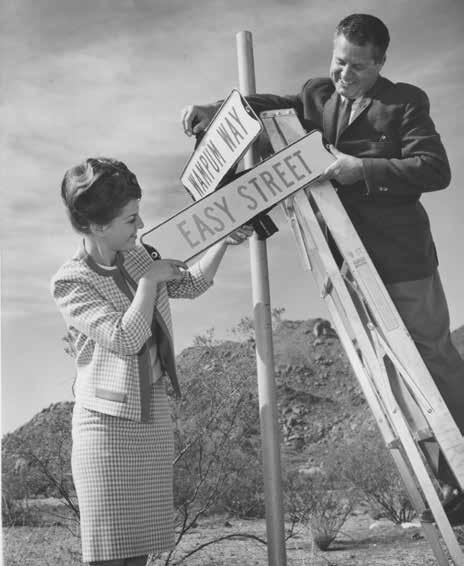
Step into the heart of Carefree with Images Arizona’s new podcast series, “Carefree Conversations.” As the town celebrates its 40th anniversary, join us on a journey through time, exploring the hidden gems, colorful characters and enduring spirit that make Carefree truly one of a kind.
Throughout late summer and fall 2024, we’ll bring you intimate discussions with the people who know and love this unique desert oasis best. From longtime residents to local business owners, each episode peels back another layer of the town’s rich tapestry.
In the debut installment, Mayor John Crane offers an insider’s view on balancing Carefree’s small-town charm with future growth while providing exclusive insights into this season’s 40th anniversary celebrations. The second installment features Preston Westmoreland, local historian and former radio personality, who uncovers celebrity hideaways, geological wonders and fascinating characters from Carefree’s early days, giving listeners a sneak peek at his upcoming historical happy hour.
Don’t miss a single story — scan the QR code or search for Images Arizona on Spotify or your favorite podcast platform to listen to the first two installments of “Carefree Conversations” today. And join us all season long as we celebrate 40 years of the Carefree life, one captivating conversation at a time.

carefree40.com
Alex Šepkus jewelry has been known for its distinct design, signature textures and microscopic details. Collected and coveted around the world, Alex Šepkus jewelry is recognized not only for its original and inimitable design, but also for the use of often unexpected stones and unique color combinations.
THURSDAY AND FRIDAY 10 a.m. to 5 p.m. [ ]


Writer Joseph J. Airdo

‘FULLY COMMITTED’
Photo by Brennen Russell
Experience the hilarious one-person show “Fully Committed” at The Phoenix Theatre Company. This unique production features two actors alternating in the lead role of Sam, a reservations manager at a trendy New York City restaurant. Watch as Sam juggles frantic calls, eccentric customers and personal dilemmas in this fast-paced comedy. With each actor playing 40 different characters, audiences can enjoy a fresh experience on different nights. $55+. See website for times. The Phoenix Theatre Company, 1825 N. Central Ave., Phoenix. 602-254-2151; phoenixtheatre.com
‘THE LITTLE MERMAID’
Dive into the magical world of Disney’s “The Little Mermaid” with Arizona Broadway Theatre’s enchanting production. Follow Ariel’s quest for true love and selfdiscovery in this beloved musical adventure. See website for price and times. Arizona Broadway Theatre, 7701 W. Paradise Lane, Peoria. 623-776-8400; azbroadway.org
‘PUFFS’
Experience the magical world of wizardry from a new perspective with Starlight Community Theater’s production of “Puffs, or Seven Increasingly Eventful Years at a Certain School of Magic and Magic.” This clever and hilarious play follows the adventures of a group of well-meaning, loyal outsiders just trying to make it through magic school. Discover the untold stories of the “Puffs” as they navigate the challenges of growing up and finding their place in a world of magic and mischief. $25. See website for times. Starlight Community Theater, 1611 W. Whispering Wind Drive, Phoenix. 623-252-9342; starlightcommunitytheater.com
Experience the dazzling and provocative musical “Cabaret” at The Phoenix Theatre Company. Set in 1930s Berlin, this Tony Award-winning show follows the interwoven stories of a cabaret singer, a young writer and the colorful characters of the Kit Kat Club against the backdrop of a changing Germany. With iconic songs like “Willkommen” and “Maybe This Time,” “Cabaret” delivers a powerful message about the resilience of the human spirit. See website for prices and times. Mainstage Theatre at The Phoenix Theatre Company, 1825 N. Central Ave., Phoenix. 602-254-2151; phoenixtheatre.com
SUMMER PERFORMING ARTS
INSTITUTE CONVENTION
Enhance your performing arts skills at the Summer Performing Arts Institute Convention, hosted by Musical Theatre of Anthem. Participants aged 8–11, 12–16 and 17–21 will choose between elective classes only or elective classes and performance, with targeted instruction based on age and skill level. $200+. See website for schedule. Musical Theatre of Anthem, 42201 N. 41st Drive, Suite B100, Anthem. 623-336-6001; musicaltheatreofanthem.org
Aug. 3–4
PRESCOTT FINE ART AND WINE FESTIVAL
Immerse yourself in the enchanting ambiance of the Prescott Fine Art and Wine Festival. Celebrate the Mountain
Artists Guild’s 75th anniversary as you explore a juried exhibition of exceptional fine art from up to 115 vendors, showcasing diverse mediums and styles. Attendees 21+ can elevate their experience with exclusive wine-tasting tickets, featuring acclaimed wines from Arizona’s Willcox Wine Country. Free admission; wine-tasting tickets available for purchase. 9 a.m.–5 p.m. Yavapai County Courthouse Plaza, 120 S. Cortez St., Prescott. vermillionpromotions.com
Aug. 9
‘INTO THE WOODS’ AUDITIONS
Embark on a magical journey at Musical Theatre of Anthem’s open auditions for the enchanting musical “Into the Woods.” This Tony Awardwinning show intertwines the plots of several Brothers Grimm fairy tales, following a baker and his wife as they venture into the woods to break a witch’s curse. With a witty and poignant score by Stephen Sondheim, “Into the Woods” explores the consequences of wishes and the choices we make. All auditioners age 14–21 are cast. $325; sibling discounts available. 4:15 p.m. Musical Theatre of Anthem, 42201 N. 41st Drive, Suite B100, Anthem. 623-336-6001; musicaltheatreofanthem.org
Aug. 10 and 11
‘CELEBRATE COUNTRY’
Immerse yourself in the vibrant world of country music at the Musical Instrument Museum’s “Celebrate Country” event. Explore the rich history and cultural impact of this beloved genre through live performances, interactive exhibits and engaging activities. Discover the stories behind iconic instruments and the artists who made them famous. $20; youth discounts available. 9 a.m.–5 p.m. Musical Instrument Museum, 4725 E. Mayo Blvd., Phoenix. 480-4786000; mim.org

Writer Joseph J. Airdo
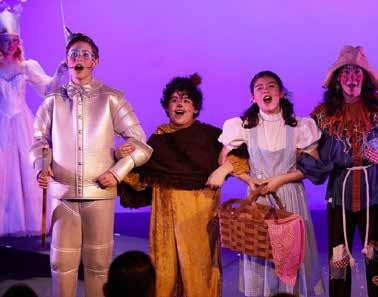
Aug. 10
Follow the yellow brick road to Musical Theatre of Anthem’s open auditions for the enchanting musical
“The Wizard of Oz Youth Edition.” This beloved tale takes you on a magical journey with Dorothy, Scarecrow, Tin Man and Cowardly Lion as they seek the great and powerful Wizard of Oz. All youth ages 6-16 who audition will be cast in this heartwarming production. $325; sibling discounts available. 10:30 a.m. Musical Theatre of Anthem, 42201 N. 41st Drive, Suite B100, Anthem. 623-336-6001; musicaltheatreofanthem.org
Aug. 19 and 20
PROMUSICA ARIZONA AUDITIONS
ProMusica Arizona Chorale and Orchestra invites talented singers and instrumentalists to audition for the 2024–25 season. Chorale auditions require intermediate music reading ability and prior choral experience. Orchestra auditions seek musicians with advanced intermediate playing level or higher. Free. By appointment only. 6:30–9 p.m. All Saints Lutheran Church, 15649 N. Seventh St., Phoenix. 602-570-4458; pmaz.org
Aug. 23–Sept. 22
‘CLUE: THE MUSICAL’
Join Arizona Broadway Theatre for a thrilling and hilarious production of “Clue: The Musical.” Based on the classic board game, this interactive musical comedy invites the audience to help solve a mysterious murder case. With multiple possible endings and a talented cast bringing the colorful suspects to life, “Clue: The Musical” promises an unforgettable evening of suspense and laughter. See website for prices and times. Arizona Broadway Theatre, 7701 W. Paradise Lane, Peoria. 623-776-8400; azbroadway.org
Aug. 31 and Sept. 1
‘EXPERIENCE MEXICO’
Embark on a captivating journey through the diverse musical traditions of Mexico at the Musical Instrument Museum. This immersive event showcases the country’s rich cultural heritage through live performances, traditional instruments and hands-on activities. Gain a deeper appreciation for the vibrant sounds and rhythms that define Mexican music. $20; youth discounts available. 9 a.m.–5 p.m. Musical Instrument Museum, 4725 E. Mayo Blvd., Phoenix. 480-478-6000; mim.org
Aug. 31 and Sept. 28
ANTHEM CARS AND COFFEE
Celebrate your passion for automobiles at Anthem Cars and Coffee’s monthly car show. Enjoy the sight of diverse vehicles, from classic to modern, while sipping coffee and indulging in tasty treats from the food court and vendors. This event fosters a vibrant community of car enthusiasts, where attendees can share their love for all things automotive in a relaxed and welcoming atmosphere. During the summer months, the show will be held under the covered parking area for your comfort. Free. 7-10 a.m. Outlets North Phoenix, 4250 W. Anthem Way, Phoenix. anthemcarsandcoffee.com
‘WE AIN’T EVER GONNA BREAK UP: THE HYMON & PARFUNKEL MUSICAL’
Experience the captivating story of the legendary musical duo Hymon and Parfunkel in the Phoenix Theatre Company’s production of “We Ain’t Ever Gonna Break Up.” This jukebox musical follows the rise, fall, and enduring legacy of the iconic pair, featuring their beloved hit songs and exploring the complexities of their creative partnership. See website for prices and times. Hardes Theatre at the Phoenix Theatre Company, 1825 N. Central Ave., Phoenix. 602-2542151; phoenixtheatre.com
JUNK IN THE TRUNK VINTAGE MARKET
Discover a treasure trove of unique finds at the Junk in the Trunk Vintage Market, returning to WestWorld in Scottsdale. With more than 160 vendors from across the country, this semiannual event showcases an eclectic mix of vintage, antique, and handmade goods, including clothing, jewelry, furniture and home decor. Enjoy live music and delicious eats from local food trucks while supporting small businesses and artisans.
$8+. Friday 4–9 p.m.; Saturday 8 a.m.–3 p.m.; Sunday 10 a.m.–3 p.m. WestWorld of Scottsdale, 16601 N. Pima Road, Scottsdale. junkinthetrunkvintagemarket.com

Writer Joseph J. Airdo
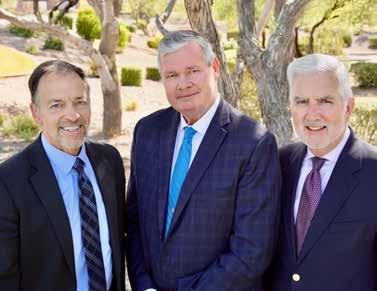
Anthem Law is pleased to announce the addition of Attorney Dwayne E. Ross to its legal team, expanding its personal injury expertise. With more than 30 years of experience representing both plaintiffs and defendants, Ross brings a unique perspective to the firm. His expertise, typically found in large metropolitan firms, combined with the personalized care of a local firm, ensures top-tier legal representation for the North Valley and surrounding communities. Ross’s distinguished career includes membership in the Million Dollar Advocates Forum and the 2023 Martindale-Hubbell Award for Excellence in Legal Ability and Ethics. anthemlaw.com
‘INTO
Embark on a magical journey with Musical Theatre of Anthem’s enchanting production of “Into the Woods.” This Tony Award-winning musical intertwines the plots of several Brothers Grimm fairy tales, following a baker and his wife as they venture into the woods to break a witch’s curse. With a witty and poignant score by Stephen Sondheim, “Into the Woods” explores the consequences of wishes and the choices we make. Performed by a talented cast of youth ages 14–21, this heartwarming and thought-provoking show will leave you spellbound. $15+. See website for times. Musical Theatre of Anthem, 42201 N. 41st Drive, Suite B100, Anthem. 623-336-6001; musicaltheatreofanthem.org
Indulge in the flavors of Arizona during the highly anticipated Fall Restaurant Week. This 10-day culinary celebration showcases the diverse and vibrant dining scene across the state, with a particular focus on the greater Phoenix area. Participating restaurants offer specially curated, multicourse prix fixe menus, allowing diners to experience high-quality cuisine at exceptional values. Whether you’re a foodie looking to try new establishments or a casual diner seeking a great deal, Restaurant Week provides the perfect opportunity to explore Arizona’s rich culinary landscape. Prices and menus vary by restaurant. Reservations recommended. See website for participating restaurants. arizonarestaurantweek.com
Experience the heartwarming and uplifting musical “Waitress” at the Phoenix Theatre Company. Based on the beloved film, this Tony-nominated show follows Jenna, a talented pie maker who dreams of a way out of her small town and rocky marriage. With a score by Grammynominated singer-songwriter Sara Bareilles, “Waitress” celebrates friendship, motherhood and the courage to pursue your dreams. See website for prices and times. Hormel Theatre at the Phoenix Theatre Company, 1825 N. Central Ave., Phoenix. 602-254-2151; phoenixtheatre.com
WorkMoney, a national nonprofit dedicated to raising incomes and lowering costs, now offers tailored support to Phoenix-area residents. Through live chat at workmoney. org or by calling or texting 1-833-WRK-MNEY (1-833975-6639), individuals can connect with agents to access new and underutilized government programs. WorkMoney aims to help Phoenicians save on utility bills, groceries and
other expenses, with the potential to put thousands of extra dollars back in their pockets. WorkMoney can provide information on more than 50 programs, tax credits and rebates, including assistance for homebuying, health insurance, child care and more. workmoney.org
MUSICAL THEATRE ANNOUNCES NEW CLASS SCHEDULE
Musical Theatre of Anthem has unveiled its new weekly class schedule, offering a diverse range of courses for performers ages 7–18. The lineup includes improv games, tap technique, acting, vocal technique and audition prep, jazz/musical theater dance, and dance technique classes. These Tuesday sessions provide opportunities for students to hone their skills in various aspects of musical theater. Participants can choose between a full 26-week series for $250 or drop in for individual classes at $10 per session. Musical Theatre of Anthem, 42201 N. 41st Drive, Suite B100, Anthem. musicaltheatreofanthem.org
MUSICAL THEATRE INTRODUCES ‘MINIS MUSICAL’ PROGRAM
Musical Theatre of Anthem is expanding its offerings with the new “Minis Musical” program for children ages 4–7. This 12week course introduces young performers to the basics of musical theater, culminating in a themed performance in December. Participants will learn songs, dances and scenes in preparation for their show. $295. Tuesdays 4–5:15 p.m. Musical Theatre of Anthem, 42201 N. 41st Drive, Suite B100, Anthem. musicaltheatreofanthem.org


AArizona, long known for its breathtaking natural wonders, is increasingly recognized for its human diversity. From the bustling streets of Scottsdale to the quiet corners of Carefree, the state has become a tapestry woven with threads of cultures from across the globe. Each community, regardless of its size, contributes its unique hues to this rich cultural mosaic.
This diversity is far more than a mere statistic; it’s the very lifeblood of Arizona’s modern identity. It’s present in every sensory experience: the tantalizing aroma of authentic Greek souvlaki wafting from a downtown Phoenix food truck; the rhythmic beats of African drums resonating through a Tempe community center; the dazzling display of Chinese lanterns illuminating a Glendale festival against the backdrop of a Sonoran sunset.
These are the stories of those who’ve chosen to transplant their roots into Arizona’s sunbaked soil. They’ve brought with them not just suitcases, but entire worlds — ancestral traditions, time-honored cuisines and customs as old as the cultures themselves. In doing so, they’ve not only preserved their heritage but have woven it inextricably into the fabric of the Grand Canyon State.
This summer, Images Arizona embarks on a journey through Arizona’s cultural landscape. We’ll explore the vibrant communities that have made this desert their home, discovering how they’ve not only adapted to their new environment but have fundamentally reshaped it, creating an oasis of global culture in the heart of the American Southwest.

Writer Joseph J. Airdo
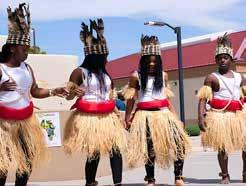


From the vibrant rhythms of Lagos street markets to the sun-drenched savannas of Kenya, the heartbeat of Africa pulses through the desert landscape of Arizona.
“Africans in Arizona are by no means monolithic,” African Association of Arizona leadership explains. “They come from the second-largest continent in the world that comprises more than 1.3 billion people from across 55 countries.”
This diversity is reflected in the more than 3,000 ethnic groups and languages represented, as well as a variety of religious practices including Christianity, Islam, Judaism, Hinduism and indigenous African religions.
Far from being isolated, the African community has become an integral part of Arizona life.
“Not only have Africans in Arizona adequately integrated into the local community, but they continue to contribute substantially to it in innumerable ways,” notes AFASA leadership, adding that Africans’ impact can be seen across various sectors, from education and sports to business and the arts.
One of the most delicious ways Arizonans experience African culture is through food. A “visible proliferation of African restaurants, food trucks and catering services” has introduced locals to the continent’s rich culinary traditions. Imagine savoring the complex spices of Ethiopian injera or the comforting warmth of West African jollof rice — all without leaving the Grand Canyon State.
However, African influence extends far beyond the palate.
“Local African artists and entertainers have added to the Arizona cultural landscape by introducing diverse musical styles, such as Afrobeat and African hip-hop, dance and visual arts,” shares AFASA leadership, noting that these artistic expressions provide a vibrant soundtrack and colorful backdrop to Arizona’s cultural scene.
For those seeking a deeper dive into African heritage, AFASA has been organizing annual festivals since 1998. These family-friendly events, which can draw up to 5,000 attendees, offer a multisensory experience of African culture. From traditional dances to artisanal crafts, the festivals serve as a bridge between cultures, fostering understanding and appreciation.
AFASA leadership adds that local Africans are “active in various sectors of the state’s economy, including academia, medicine, engineering, law, education and information technology.” Their entrepreneurial spirit has led to the establishment of businesses across multiple industries, contributing to job creation and economic growth.
This influx of talent and diversity hasn’t gone unnoticed.
“African entrepreneurs and African-owned enterprises are contributing to the local economy through revenue generation, taxes, job creation, economic growth and more,” AFASA leadership says.
As we look to the future, the African presence in Arizona seems poised for continued growth and integration. Despite occasional challenges, AFASA remains optimistic.
“Africans, in general, are pathological optimists,” the association’s leadership explains. “Consequently, despite the occasional hiccups and discomforts experienced by Africans in the local community, the future of Africa in Arizona looks promising.”
afasa.org
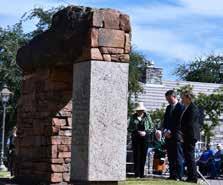
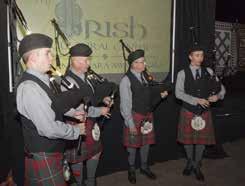

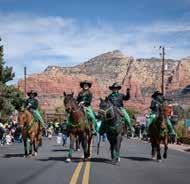
Arizona is home to a vibrant and growing Irish community that is painting the desert landscape with shades of green, infusing the Southwest with the spirit of the old country. From bustling St. Patrick’s Day parades to quiet corners in local pubs where Gaelic whispers blend with the twang of country music, Irish culture has found an unlikely but welcoming home in the state.
“Maricopa County is home to the fourthlargest Irish population in the country, based on the latest U.S. Census data,” says Ciara Wittkowski, operations director at the Irish Cultural Center and McClelland Library in Phoenix. “With the major tech companies in the Valley bringing expatriates to the state, our Irish population is growing rapidly.”
This burgeoning community has woven itself into the fabric of Arizona life, bringing with it a rich tapestry of traditions, events and cultural contributions. At the heart of this cultural exchange stands the Irish Cultural Center, celebrating its 25th anniversary this year.
“We provide more than 100 events a year to the Arizona community that foster cultural appreciation and education,” Wittkowski explains.
These range from youth summer camps focused on Irish dance and music to genealogy workshops and concerts featuring Irish artists. One of the center’s most significant events is the
annual St. Patrick’s Day Parade and Faire, a tradition spanning more than four decades.
“This family-friendly event is hosted in Hance Park and at the Irish Cultural Center and McClelland Library and welcomes thousands of patrons each year,” Wittkowski says.
But Irish culture in Arizona isn’t confined to March 17. Throughout the year, the center hosts events that highlight different aspects of Irish history and tradition.
“For 20 years, we have hosted a ‘1916 Easter Rising Commemoration,’ which highlights Ireland’s rebellion against British rule and eventual independence,” Wittkowski notes.
The center also shines a light on lesserknown aspects of Irish history. This year, it’s reviving its Irish in Latin America exhibit, which includes a section on the San Patricios, a group of Irish soldiers who fought for Mexico during the Mexican-American War.
Beyond the center, Irish culture permeates Arizona in various ways. The state boasts six Irish sister cities, from Phoenix’s partnership with Ennis in County Clare to Tucson’s connection with Roscommon. These relationships foster cultural and economic ties between Arizona and Ireland.
For many in the Irish community, local pubs serve as more than just watering holes.
“The Irish pub is essential to the Irish ecosystem,” Wittkowski explains. “For many immigrants, these places serve as the first point of contact to their new home — connecting with people with a similar backstory or networking to find new connections or jobs.”
Sports enthusiasts can even catch traditional Irish games, thanks to the Brian Boru GAA team, which plays hurling and Gaelic football in Arizona.
As a first-generation Irish American, Wittkowski sees a bright future for Irish culture in Arizona.
“Ireland’s presence in Arizona will only continue to grow,” she predicts. “I hope one day to see a direct flight to Ireland like London and Paris now have.”
With the recent establishment of the Arizona-Ireland Trade Commission, which aims to promote business and academic exchanges, the bonds between Arizona and Ireland are set to strengthen further.
“We’ve lost quite a few important members of our community this year and over the last few years,” Wittkowski reflects. “I hope to honor their legacy and continue the work done by so many before me to showcase our slice of Ireland in the desert.”
azirish.org
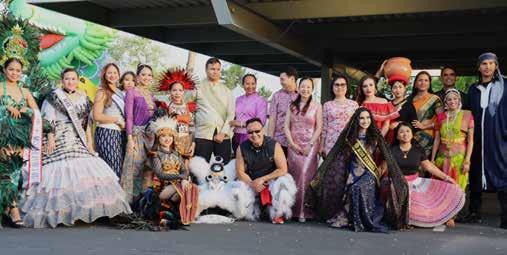
From the fragrant aromas of authentic pho kitchens to the serene beauty of Buddhist temples, Asian culture has become an integral part of Arizona’s diverse tapestry.
At the forefront of promoting Asian culture and fostering understanding between communities is the Arizona Asian American Association. Founded in the late 1980s, the organization has been instrumental in showcasing Asian heritage to all Arizonans.
“The Asian community is a rapidly growing population in Arizona,” the association’s leadership notes. “The different ethnicities of Asians are also quite diverse. The Arizona Asian American Association engages more than 20 different Asian ethnicities. Asians represent an integral segment of society in the workforce, economic buying power and also social and political influence.”
AAAA’s flagship event, the Asian Festival, was a pioneering effort in the state, significantly expanding the association’s reach into partnerships and collaborations with corporations, sports entities and the Musical Instrument Museum.
But the cultural offerings extend far beyond this single festival. Throughout the year, Arizona’s Asian communities celebrate a plethora of holidays and traditions, many of which date back centuries.


“There are significant holidays within each Asian ethnic community,” AAAA leadership explains. “These are time-honored traditions. Some of the holidays, ceremonies and rituals extend back to antiquity. With each, we honor our ancestors.”
The AAAA’s mission goes beyond mere celebration. It strives to preserve and evolve the indigenous cultures of its ancestors, creating a bridge between the old and the new, the East and the West.
“Culture, civics, social issues, fellowship and assimilation are the common bonds,” the association’s leadership notes.
For many Asian Arizonans, this cultural identity is more than just a set of traditions — it’s an integral part of who they are.
“Asian ethnicity is not a choice but rather something we are born as,” AAAA’s leadership reflects. “It’s in our DNA. It is our values, ethics and dedication to family that define our culture.”
As Arizona continues to grow and evolve, its Asian communities are poised to play an increasingly significant role. Their contributions — from cuisine to commerce, from art to innovation — are helping to shape a more diverse, vibrant and globally connected Arizona.
azasianamerican.com
Our journey through Arizona's diverse communities continues online. Scan the QR code or visit imagesarizona.com to explore exclusive profiles of even more cultures shaping our state, from the vibrant Arabian community to the rich traditions of Greek expatriates. Discover how these unique heritages contribute to Arizona's colorful cultural mosaic.

From the clinking of pint glasses in authentic pubs to the fluttering of Union Jacks during royal celebrations, Arizona has embraced a surprising slice of British charm amid its desert landscape. This unexpected cultural fusion has transformed parts of the state into a home away from home for British expatriates and Anglophiles alike, offering a unique blend of Southwest hospitality and British tradition.
Jo Gemmill, owner of the English Rose Tea Room in Carefree, remembers her initial culture shock upon arriving in Arizona more than two decades ago.
“As a Brit arriving in Arizona more than 20 years ago, I was shocked to find a piece of my home country right here in the middle of the desert,” says Gemmill, pointing to the incongruous sight of the London Bridge in Lake Havasu City as a prime example of this cultural crossover.
For British transplants like Gemmill, finding familiar touchstones can ease the transition to life in a new country.
“I think whenever people from other nations move to a different country, there is a certain familiarity and quelling of homesickness if you can seek out and find things that remind you of home,” she explains.
One of the most prominent British imports to take root in Arizona is pub culture. Establishments like George and Dragon English Pub in Phoenix have brought a taste of U.K. nightlife to the Valley. However, Gemmill notes some key differences.
“The pubs in England have the benefit of the patina of time: worn floors, aged bricks, historical buildings and the distinctive smell of years of serving beer,” she says. “In Arizona, the British pub culture seems to focus more on the popularity of British sport, namely soccer.”
Culinary offerings also play a significant role in maintaining British culture in Arizona. Fish and chips shops, like the now-closed Cod Father and the upcoming Englishman Fish & Chips (served from a stationary London bus), have satisfied cravings for this classic British comfort food.
“Cod and chips with a healthy serving of mushy peas ... the tang of malt vinegar and the taste of beer batter immediately transports me back to my local chippy at home,” Gemmill fondly notes.
Gemmill’s own English Rose Tea Room has become a focal point for British culture in the state since its opening in 2002. The tea room has hosted numerous events celebrating British
milestones, from royal weddings to Queen Elizabeth II’s Platinum Jubilee.
“The popularity of the English Rose Tea Room has been overwhelming,” Gemmill says. “Now it seems everyone in the state has heard of us.”
The connection between Arizonans and British culture deepened following Queen Elizabeth II’s death.
“The outpouring of grief and personal support was amazing,” Gemmill recalls. “The public responded to the tea room and to me personally in such a profound and caring manner it was as if my own relative had died. That was a turning point for me in how embedded British culture has become in Arizona.”
Despite the cultural differences, Gemmill has found a warm welcome in Arizona.
“Americans and Brits will always have a kindred spirit,” she says. “I have never felt like an outsider living here in Arizona. I have only ever encountered warm and friendly people, some of whom have a fascination with Britain, all things royal and, of course, the English accent!”
carefreetea.com
From the melodic sounds of French conversations in local cafes to the aroma of freshly baked croissants wafting through farmers’ markets, Arizona’s French community has transformed parts of the state into a surprising oasis of French culture, thousands of miles from the banks of the Seine.
The roots of the state’s Francophone presence trace back to the 1980s when major corporations like Honeywell and STMicroelectronics brought French expatriates and their families to Phoenix. This influx sparked a need for French education, leading to the establishment of the International School of Arizona in 1997.
“Still going strong today, it caters to students from preschool to middle school,” explains Leanne Debeurre, a member of the French community who has called Arizona home for the past 37 years. “Other French schools have popped up around the Valley to keep up with demand.”
At the heart of Arizona’s French cultural scene is the Alliance Française of Greater Phoenix, founded in 1987. This nonprofit organization, part of a global network dating back to 1883, has become a cornerstone for French language education and cultural exchange.
“It would be very difficult to search for French cultural organizations in the Valley and not have the Alliance Française of Greater Phoenix bubble to the top of the list,” says Debeurre, who serves as the organization’s vice president and treasurer.
The Alliance Française of Greater Phoenix offers a variety of activities that bring a touch of Paris to the desert. From lively Bastille Day celebrations to sophisticated Beaujolais nouveau wine tastings, these events provide a platform for both French
speakers and Francophiles to immerse themselves in the culture.
One standout event is the annual Night of Ideas (La Nuit des Idées), a global initiative in which Francophone organizations worldwide engage in debates on pressing issues.
“Last year, our theme was water usage and conservation in Arizona, and this year the discussion was around how cuttingedge technologies are changing the face of Phoenix,” Debeurre shares.
But the French influence extends beyond organized events. It’s woven into the fabric of Arizona’s culinary scene, with French restaurants like Vincent’s on Camelback having welcomed U.S. presidents and other dignitaries over the years.
Perhaps the most intriguing testament to the enduring Franco-American friendship lies in an unexpected place — the McCormickStillman Railroad Park. Here, visitors can find a piece of the Merci Train, a gift from France to the United States following World War II.
“This is a story that needs to be remembered as a way of highlighting the friendship between the two cultures,” Debeurre emphasizes.
Looking to the future, the French presence in Arizona shows no signs of waning. The recent addition of direct flights from Phoenix to Paris by Air France underscores the growing connection between the two cultures.
“I believe that we will see the presence of French and French-speaking people continue to prosper and flourish here,” Debeurre predicts. “As you can see, we have the infrastructure, the support, the companies and the cultural activities to meet the needs of all.”
afphx.org
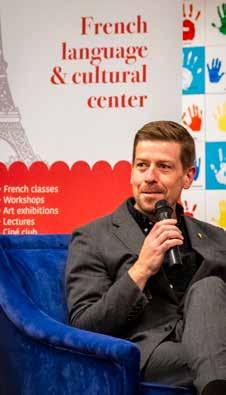



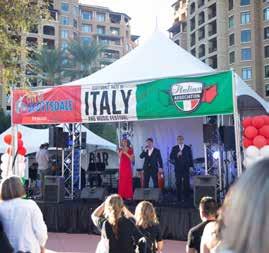


Whether you’re savoring a perfectly crafted espresso, learning to roll homemade pasta or simply enjoying the strains of an Italian aria floating on the desert breeze, the spirit of Italy is alive and well in the Southwest.
The roots of this vibrant community stretch back to the late 19th and early 20th centuries, when Italian immigrants, lured by opportunities in mining, railroads and agriculture, first set foot on Arizona soil. Over time, they established close-knit communities in Phoenix and Tucson, laying the foundation for a lasting Italian presence.
Today, the Italian Association of Arizona stands as a testament to this enduring legacy. Founded in 2013, the nonprofit organization has become the beating heart of Italian culture in the state.
“We work on promoting Italian culture and heritage through various cultural, social and educational activities,” says Rosa Torraca, treasurer and board member for the association.
These activities paint a vivid picture of Italian life in the desert. Happy hour gatherings buzz with animated conversations in both English and Italian. Wine-tasting events transport attendees to the sun-drenched vineyards of Tuscany and Piedmont. For those eager to master the language of Dante, the association offers Italian classes led by Arizona State University professors and other instructors.
But perhaps the crown jewel in the association’s cultural calendar is the annual Italian Festival. Set against the backdrop of Scottsdale’s picturesque waterfront along the Arizona Canal, this two-day extravaganza is a feast for the senses.
“We will be bringing some great local Italian restaurants so attendees can experience delicious cuisine, cannoli, gelato and much more, supporting local hardworking Italians who share traditional recipes from their own Italian regions and bring a taste of Italy to Arizona,” enthuses Torraca, noting that this year’s event is scheduled for Oct. 19 and 20.
The festival, now in its ninth year, goes beyond mere gastronomy. It’s a celebration of all things Italian — from fashion shows that showcase the latest Milan trends to wine tasting areas that rival the finest enotecas. Live music fills the air, transporting visitors to the bustling piazzas of Rome or the romantic canals of Venice.
Yet, the association’s impact extends far beyond cultural celebrations.
“We also work on community volunteer events, with the most popular being the pizza-making event through St. Vincent de Paul in Phoenix,” Torraca notes.
This blend of Italian tradition and local community service epitomizes the association’s commitment to enriching Arizona’s social fabric.
Looking to the future, the Italian Association of Arizona has big aspirations.
“Our ultimate dream and goal [is] to have our own Italian cultural center in the Valley,” Torraca shares.
Envisioned as “Arizona’s own Little Italy,” this center would serve as a hub for cooking classes, language instruction and cultural events, further cementing the Italian community’s place in Arizona’s multicultural landscape.
italianassociation.org
In a land where saguaros stand sentinel instead of windmills, a small but mighty Dutch community has planted roots, infusing the Arizona desert with its rich heritage and entrepreneurial zeal.
“The Dutch community in Arizona is very small, with around 1% of the state’s population being Dutch,” says Ilse Chaigneau, a Dutch native who has called Arizona home for more than six years.
Despite their small numbers, the Dutch have woven themselves into the fabric of Arizona life, bringing with them a rich tapestry of traditions and a dash of European flair. One organization keeping Dutch culture alive in the desert is the Dutch Connection of Arizona. This active group hosts events that transport attendees straight to the canals of Amsterdam, if only for a day.
“Its main events are King’s Day, which celebrates the king’s birthday and is a huge celebration in the Netherlands, and Sinterklaas, who is the Dutch equivalent of Santa Claus,” Chaigneau explains.
Imagine the surprise of seeing Sinterklaas, complete with his colorful helpers, navigating the arid Arizona landscape instead of the canals of Amsterdam. It’s a sight that perfectly encapsulates the unique blend of cultures in the state.
But it’s not just about celebrations. The Dutch influence in Arizona runs deeper, touching various sectors of the state’s economy and society.
“There are several Dutch companies that have operations in Arizona,” Chaigneau notes. “For example, ASML, ASM International, NXP and Philips Healthcare are actively involved here, some of them for decades.”
These companies contribute significantly to Arizona’s economy, with exports from Arizona to the Netherlands valued at about $618 million. The Netherlands ranks as Arizona’s seventh-largest export partner and ninth-largest import partner, accounting for more than 8,700 jobs in the state.
Even the skies above Arizona have a touch of Dutch influence.
“It is also a point of Dutch pride that an increasing number of pilots from the Royal Netherlands Air Force are receiving their training in Arizona,” Chaigneau adds.
Despite their contributions, the Dutch community in Arizona maintains a low profile.
“The Dutch are very open-minded and easygoing, which is probably why many enjoy living in Arizona,” Chaigneau says. “This is probably also the reason that the Dutch adapt to where they live, and although they hold on to some traditions, they are also very happy to enjoy new ones.”
This adaptability doesn’t mean forgetting their roots, however. Chaigneau herself works to keep her heritage alive.
“I am proud to be Dutch, and it is my mother tongue,” she explains. “I work to keep my language skills by reading, speaking and doing crossword puzzles in Dutch ... [and] cook Dutch meals for my family and friends.”
dutchclubarizona.com



IIn the world of competitive swimming, records are made to be broken. But for 15-year-old Delaney Barbee of Anthem, it’s not just about shattering time records — it’s about making history.
This summer, Delaney became the first swimmer to represent the Arizona Dolphins at the Olympic trials while still a member of the team. In the Dolphins’ 25-year history, this feat stands unmatched, marking a new era for the Anthembased swim club.
“It’s awesome to represent the team that I started on when I was a little kid learning the strokes, to now competing at the fastest meet in the world,” Delaney says, her pride evident. “I hope my teammates and the younger kids on my team can look up to me in a way to see that if they keep working, they can achieve their goals, too.”
Delaney’s journey to the Olympic trials began far from the pool. At age 9, a broken arm from gymnastics led her mother to suggest swimming as an alternative. What started as a casual foray into a new sport quickly revealed an innate talent.


“When Delaney was 8 or 9, she broke her arm at gymnastics,” recalls her father, Mark Barbee. “This led us to encourage her to try a recreational swim program, where she excelled. It was clear to her mom, Libby, and me that she had a natural comfort in the water and was making rapid progress.”
That natural comfort has since transformed into a formidable competitive edge. As a freshman at Boulder Creek High School in Anthem last fall, Delaney clinched three Division I state championships in individual events, contributing significantly to Boulder Creek’s third-place finish in the overall state rankings.
But it was on May 24 of this year that Delaney truly made waves, qualifying for the Olympic trials. The trials, held in June at a converted Colts stadium in Indianapolis, saw Delaney compete on June 22 in the 50-meter freestyle event. She placed 70th out of 79 competitors.
“Being in that environment the days leading up to my race definitely made me excited,” Delaney reflects. “The day of my race, I was nervous but mostly excited to race in such a cool venue with the fastest swimmers in the country and world.”
It’s awesome to represent the team that I started on when I was a little kid learning the strokes to now competing at the fastest meet in the world. Delaney Barbee



Delaney has an exceptional feel for the water; she moves very well through it.
Her father echoes this sentiment, describing the electrifying atmosphere at Lucas Oil Stadium.
“Inside the stadium, the atmosphere was electrifying,” he explains. “The evening sessions featured bright lights, loud music and energetic emcees to pump up the crowd. It’s an understatement to say that the energy was palpable.”
Behind Delaney’s success lies a rigorous training regimen.
“I swim eight times a week for a total of 14 hours, so I do double practices Tuesdays and Thursdays,” she explains.
This dedication, combined with her natural talent, sets her apart in the pool.
Paul Root, head coach of the Arizona Dolphins, attests to Delaney’s unique abilities.
“Delaney has an exceptional feel for the water; she moves very well through it,” Root says. “She’s also an extremely powerful athlete, which makes her close to unbeatable in a 50-yard freestyle.”
However, Root emphasizes that Delaney’s greatest strength lies beyond her physical capabilities.
“She wants to be great and has had great opportunities to see what that takes,” he explains. “While doing so, she hasn’t lost sight of who she is away from the sport.”
Indeed, Delaney’s life extends far beyond the pool. As a home-schooled student, she enjoys a flexible schedule that allows her to balance her rigorous training with her studies and social life.
“School only takes a few hours for me, so I can prioritize rest and recovery and make sure I fuel my body properly before and after practice,” Delaney says. “I’m also very involved with my church, CCV Anthem, and I’m almost always with friends when I’m not at practice or a meet.”
This balance is crucial, not just for Delaney’s personal growth, but for her athletic performance as well.
“I try not to put too much pressure on myself because swimming is something I do, not who I am,” she explains, demonstrating a maturity beyond her years.
As Delaney sets her sights on future goals, including a spot on the U.S. National Team and competing at the Olympics, her recent experience at the trials has only fueled her ambition.
“Qualifying for the trials is a huge milestone for me,” she says. “Being at trials, I know I’m definitely on the right path to reach that goal.”
As Anthem cheers on its homegrown champion, Delaney continues to prove that with dedication, balance and a supportive community, even the biggest dreams can become a reality. From the local pools of Anthem to the grand stages of national competitions, Delaney is not just making waves — she’s creating ripples of inspiration that extend far beyond the water’s edge.


WWhile Arizona shares only one international border, with Mexico, the state relies on global connections and economic partnerships to compete on the world stage.
The Phoenix Sister Cities program, established in 1972 as part of the City of Phoenix Community and Economic Development initiatives, maintains relationships with 11 cities worldwide. Its Youth Ambassadors program embodies the organization’s mission: to foster “relationships between the people of Phoenix and our Sister Cities around the world to promote friendship, peace and prosperity.”
Mayors of sister cities sign agreements and outline plans to exchange delegations of students, educators, political and business leaders, and representatives of the arts community. Volunteer committees support these efforts. One of the program’s gems is the Education and Youth Ambassador programs, led by Xavier Corella.
“Our education programs help our residents see the world through a different lens,” says Corella, the organization’s youth and education coordinator. “We often hear about negative events worldwide; however, we usually lack one key piece: perspective. That’s where we come in; our education program strives to provide that additional cultural and geographical context to better understand the complex problems on our global stage.”
For 45 years, the Youth Ambassador Exchange Program has sent Arizona high school sophomores and juniors on two- to three-week adventures each summer. Upon return, they host their foreign counterparts in Phoenix in July, reciprocating the hospitality.
Our education programs help our residents see the world through a different lens. We often hear about negative events worldwide; however, we usually lack one key piece: perspective. That’s where we come in; our education program strives to provide that additional cultural and geographical context to better understand the complex problems on our global stage. Xavier Corella
The program accepts up to 30 participants annually and has amassed 1,100 alumni. While location availability can vary due to regional conflicts, there are 11 participating cities: Calgary, Alberta, Canada; Catania, Italy; Chengdu, China; Ennis, Ireland; Grenoble, France; Hermosillo, Mexico; Himeji, Japan; Prague, Czech Republic; Ramat Gan, Israel; Taipei, Taiwan; and Suwon, South Korea.
Corella notes that parents are more hesitant to allow their teens to travel, but participants spend a full semester preparing through meetings, activities, fundraisers and events.
Students apply by late January. Once accepted, the program board assigns cities, announcing placements in a special ceremony. Counterparts are introduced beforehand to foster relationships. Three “academy sessions” provide training from alumni, volunteers, committee members




Phoenix Sister Cities International Book Club
‘Conversations with Friends: A Novel’ by Sally Rooney
Monday, Sept. 23 6–7:15 p.m.
Held Virtually Registration Required Free phoenixsistercities.org
and local professionals on topics ranging from managing culture shock to social media etiquette, diplomacy and crosscultural communication. Ambassadors must participate in two spring fundraisers to support activities in Phoenix. They also attend committee meetings with representatives from their assigned sister city.
In June, students embark on their adventure, living with their international teenage counterparts and families — a fully immersive experience. Host cities and families create itineraries showcasing local government, culture, food, holidays and popular activities.
When counterparts visit Phoenix for three weeks in July, they enjoy highlights such as a Grand Canyon trip, meeting Phoenix’s mayor and experiencing American holidays and a prom-style celebration.
Students cite various motivations for participating: making international friends, gaining global understanding, experiencing a new culture through a host family’s eyes and seizing a once-in-a-lifetime opportunity to view a different country from a nontourist perspective while building leadership skills. It’s a life-changing process, including for Corella.
Born and raised in Phoenix’s first sister city — Hermosillo, Mexico — Corella has lifelong connections to the program.
“My grandfather orchestrated the partnership from the Mexican side,” he recounts. “I’ve always been involved in activities. I became a Youth Ambassador and came to Phoenix as a counterpart from Hermosillo in 2013. This experience changed my views on living in the U.S. I decided to attend college here, liked it so much I completed my MBA here as well, and then received the job offer to become the youth and education coordinator.
“Personally, this job means continuing my grandfather’s legacy and his vision of creating a united society — one that grows together and understands neighbors’ problems, one that helps rather than criticizes, one that helps you grow together.”
Corella also oversees the Phoenix Sister Cities Teach Abroad programs, offered in Himeji, Japan, and — recently added — Catania, Italy. About five teachers per year are sent to Japan. It’s a professional experience that opens new doors and brings fresh perspectives for young professionals.
“This experience means something different for each person,” Corella says. “It’s not just for [recent] college graduates; we’ve found that most people are midcareer and need a break or change of pace, so they seize this opportunity.”
Successful applicants must be U.S. citizens residing in the greater Phoenix metropolitan area and possess a four-year degree. They receive a contract to teach for a full school year. Fluency in Japanese or Italian is not required, nor is a teaching certificate, though supervisor positions in the Himeji program require certification.
As with Youth Ambassadors, English teachers’ preparation includes participating in Sister City committee meetings and events, receiving instruction on required paperwork, language and customs, and practicing lesson plans.
“Participants come from all walks of life,” Corella says. “This may mean something completely different for every person who starts this program. They all have their reasons; some seek adventure and some seek a new outlook on life.”
Corella shared the experience of a former teacher who asked to remain anonymous.
She was nearing retirement as an elementary English teacher in Phoenix. She and her husband had planned to purchase a recreational vehicle to tour Mexico, but he died months before her retirement.
“It was a rough couple of months,” she recalled. “How do you go on without the person who was beside you for most of your life? I fell into a depressing routine of staying home and not living. About a year after my husband’s passing, a friend told me about this program, and I signed up. To my surprise, I got the position, and before I knew it, I was on a plane to Japan. I had a great year abroad. I did what I loved: teaching. I found new meaning in my life.”
The experience prompted her to come out of retirement; she now teaches English to seniors new to the U.S. She still plans to buy that RV and travel throughout Mexico, hoping to find someone to teach her Spanish.
Stateside, programs allow Phoenicians to get involved without a passport. The Phoenix Sister Cities International Book Club, characterized as “a voyage through countries and cultures,” is free and open to the public with an RSVP.
A new book is featured every other month, attracting primarily adult readers. Hosting rotates among the organization’s 12 committees, representing the 11 sister cities and the Disabilities Awareness Committee.
The Disabilities Awareness Committee, established by Phoenix Sister Cities as the first of its kind in the country, is an award-winning program recognized for excellence. It includes the International Competition for Artists with Disabilities and the International Competition for Writers with Disabilities. Other initiatives include adaptive recreation exchanges, training workshops, online educational resources about disabilities, mobility and accessibility, and a holiday teddy bear and book event benefiting children with special needs and pediatric cancer patients.
“We have many activities for artists of all ages,” Corella says. “We have writing competitions, art and drawing competitions, etc. Each happens once a year. We encourage people to stay informed about these programs by joining the committee or signing up for our newsletter. If I can say something about our organization, it’s that we will find a way to make sure we find you a spot to join us.”
phoenixsistercities.org


SSun-baked deserts may dominate outsiders’ perceptions of Arizona, but photographer Kelly Hahs reveals a different story through her lens as she uncovers a world of exotic beauty that rivals international destinations. Her images, captured with nothing more than a tripod and an adventurous spirit, transport viewers to lush oases, azure waters and dramatic canyons that seem a world away from the typical Southwestern landscape.
“The biggest misconception I think Arizona has is that it is ‘just a desert,’” Hahs says. “Arizona is so much more.”
Hahs, who grew up in the Midwest, fell in love with Arizona’s diverse terrain after moving to the state. Her photography journey began in 2013 following a personal tragedy that highlighted the power of images to preserve precious moments.
“I lost my dad unexpectedly in 2013, and I found so much peace looking back at our family albums,” Hahs recalls. “Those photos captured so many precious moments in time and have a way of taking me right back to that moment. It was shortly after his passing that I became obsessed with capturing my memories.”
This obsession evolved into a passion for showcasing Arizona’s hidden gems. Hahs’ images, which often feature her basking in the beauty of her surroundings, give off undeniable “vacation vibes” that challenge preconceptions about the Grand Canyon State.
“I fell in love with the desert landscape: the cacti, the mountains and uninterrupted views of the sky,” Hahs
explains. “I wanted to see it all. I started on trails and slowly built up my confidence to discover more remote places in Arizona and haven’t stopped.”
Her exploration has led her to lesser-known spots that many wouldn’t associate with Arizona: cascading waterfalls, crystal-clear lakes and verdant canyons that could easily be mistaken for tropical paradises. These discoveries are the result of Hahs’ keen eye and willingness to venture off the beaten path.
“Once I became familiar with the trails and the mountains, I started to notice more off trail,” she says. “I would see varnish and make a mental note to check that out after a good rain. Or I’d see a little arch and try to figure out the best way to reach it.”
Through her lens, Hahs invites viewers to experience Arizona’s surprising diversity and beauty. Her images serve as both a showcase of the state’s natural wonders and an invitation to explore.
“My hope would be to inspire others to get outside and explore,” Hahs says. “Nature has been so healing for me, and I hope it has the same effect on others.”
As you journey through Hahs’ Arizona, prepare to be transported to places that feel a world away, yet are hidden in plain sight within the state’s borders. These images remind us that sometimes the most exotic vacations are waiting just around the corner, hidden within our own state’s diverse landscapes.


While each of Kelly Hahs’ photographs tells a story, the tale behind her image of the canyon walls near the Confluence stands out. This shot required not just skill, but true adventurer’s grit.
“The hike to the Confluence is around 15 miles in addition to the mandatory 10-plus-mile hike you must complete before tackling the Confluence,” Hahs explains. “You leave the Indian reservation and enter Grand Canyon National Park. It was amazing to watch the canyon walls grow larger.”
The journey itself was a photographer’s dream.
“The creek that carves through the canyon is absolutely stunning,” she recalls. “Crossing the milky blue water, the remoteness of the location and watching the rams along the hike was something dreams are made of.”
But the real challenge came at the end.
“Once you approach the Confluence, you enter the Colorado River to walk into the creek, where the bluegreen water clashes with the Colorado River,” Hahs says. “When I was there, the water was flowing very fast and deep due to the snowmelt. The current was much stronger than I anticipated, and I had to have a friend help pull me through a section to complete my bucket list walk through the canyon.”
This experience encapsulates the dedication and sometimes daring nature of Hahs’ work. It also serves as a reminder of the importance of safety and preparation when exploring Arizona’s wild places.
“My advice to anyone who wants to get out and explore would be to overpack water, snacks and sunscreen,” Hahs says. “Tell someone where you are going and when you should be back. Go out, be safe and make those memories.”

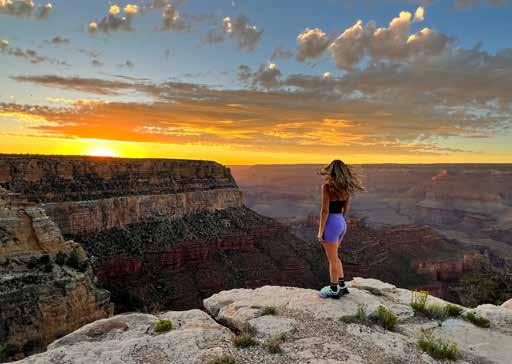
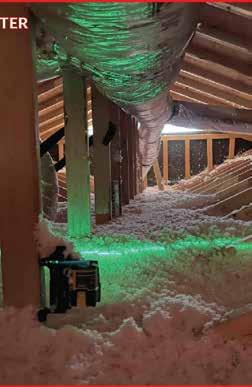



Kelly Hahs is an Arizona-based photographer whose work captures the diverse and often unexpected beauty of the Grand Canyon State. Her journey into photography began in 2013 following the sudden loss of her father. Finding solace in family photo albums, Hahs discovered the power of images to preserve memories and emotions, igniting her passion for photography.
“Photographs can capture so many feelings and preserve those little moments in time,” Hahs reflects.
Originally from the Midwest, Hahs fell in love with Arizona’s unique landscape upon moving to the state. The stark contrast between her childhood surroundings and the Southwest’s dramatic scenery fueled her desire to explore and document Arizona’s hidden gems.
“I grew up in the Midwest, and while there is charm in the Midwest, Arizona is drastically different,” she says. “I wanted to see it all.”
Hahs’ work goes beyond typical desert scenes, showcasing Arizona’s lesser-known waterfalls, canyons and oases. Her images, often featuring herself immersed in these breathtaking locations, give viewers a sense of scale and invite them to imagine themselves in these stunning settings.
With a significant Instagram following, Hahs uses her platform to challenge perceptions about Arizona and inspire others to explore the outdoors. Her photographs not only showcase the state’s beauty but also serve as a testament to the healing power of nature.
“My favorite thing about exploring Arizona is, hands down, the sunsets and sunrises here. They are just unbeatable,” Hahs enthuses. “Monsoon season brings some of the best sunsets, and I live for the smell of rain.”
Through her work, Hahs continues to uncover and share Arizona’s hidden treasures, reminding us that extraordinary beauty often lies just off the beaten path.







TTucson-raised American intellectual and writer Susan Sontag said of travel, “I haven’t been everywhere, but it’s on my list.” There are so many places to see in the world, terrain to behold, people to meet, cultures to experience and food to taste. It can even feel a bit daunting — or a strain on the pocketbook — to consider all the places you’d like to visit.
Fortunately, our Valley is a vibrant mosaic of global cuisines, with acclaimed restaurants specializing in authentic dishes from every corner of the map. This summer, Images Arizona invites readers to embark on a culinary odyssey right here in our backyard.
Grab your appetite and sense of adventure as we take you from the sun-drenched vineyards of France to the bustling izakayas of Japan, the sizzling street food of Thailand and the rustic trattorias of Italy — all without leaving Arizona. Get ready to stamp your virtual dining passport as we explore the world, one delicious plate at a time.
Executive Chef Remy Lefebvre has cooked in kitchens around the world, from Michelin-starred restaurants to luxury hotels. At Francine, he returns to his French roots, combining a passion for sourcing and utilizing the freshest products with celebrity chef-founder Laurent Halasz’s vision to bring “the cooking of the sun” to the Valley of the Sun.
House-marinated olives, ratatouille, moules frites and olive oil cake scented with orange blossom syrup evoke visions of breezy days on the Mediterranean coast. Francine’s neutral interior with warm wood and brass accents, beamed ceilings, greenery and an inviting patio welcome guests to “le Midi.”
Lefebvre notes the cooking of the French Riviera is influenced heavily by the Roman Empire, with Moorish flavors from Spain, where he spent 10 years at the outset of his professional career. His most popular dishes include grilled octopus with arrabbiata sauce — an echo of that Italian influence — and a dish of marinated and grilled rack of lamb.
“The menu is French, yes, but far from classic, old-school bistro,” Lefebvre says. “It’s representative of my cooking and style of cooking — light and bold flavors, driven by what is done now in the Mediterranean. It’s refreshing brasserie fare that is high quality with accessible pricing and careful sourcing. We want people to dine often and not be limited by exclusivity of pricing.”
The freshness of ingredients is an area where Lefebvre is uncompromising. He works with local purveyors such as Noble Bread and has fostered direct relationships with fishermen for full transparency of provenance. He even has someone who shops weekly at the Santa Monica Farmers Market, seeking out the best seasonal produce, mostly organic.
Seasonal cooking means Francine’s menu will always have new flavors to try. This summer, Lefebvre is planning dishes with creamy burrata, marinated artichokes a la Grecque, branzino wrapped in fig leaves and flambeed with pastis, and a duck dish with fig dressing reminiscent of the Peking duck he prepared at Singapore’s famed Raffles Hotel.
Since arriving at Francine in November, Halasz and Lefebvre have worked to steer the menu back to its origins in the kitchen of Halasz’s mother, the restaurant’s namesake.
Lefebvre calls it a dramatic, positive change; though sometimes patrons are shocked when favorites are removed, he says many well-loved dishes remain and are being improved and refined.
“It’s the start of excellence here in Phoenix,” Lefebvre says. “Plenty of young, new chefs opening concepts, showcasing what they know and their own story. That’s what it should be: not corporate but food made with love and care.”
francinerestaurant.com
Legendary chef Nobuo Fukuda’s Hai Noon is a small restaurant that’s getting huge accolades. The 2007 James Beard Best Chef Southwest Award winner’s restaurant is set in the Papago Motor Hotel, a renovated midcentury building with variegated stone walls, banquettes and barstools reminiscent of its 1960s origins. The food and inventive cocktails served in this space are inspired by Fukuda’s years of experience and his two years of travels across Asia after closing his famed Nobuo at Teeter House in downtown Phoenix in 2021.
Open Tuesday through Saturday evenings, the modestly priced dinner menu is served from 5 to 9 p.m. Highlights include fusion dishes like grilled shishito peppers with soy sauce, queso fresco and bonito flakes; coconut curry-marinated lamb with mango-fennel salad; and kelp-cured seabream (kobujime) with cherry blossom and yuzu zest. Nobuo’s well-known spoons feature items such as grapefruit and avocado, ceviche with myoga and taro chips, or oysters.
The late-night menu, available Fridays and Saturdays from 9 p.m. to 11 p.m., offers buns filled with pork belly and pickled mustard greens, tempura-fried mushrooms and panko-fried soft-shell crab.
For the full Chef Nobuo experience, diners should try the six-course tasting menu on Wednesdays, which changes seasonally.

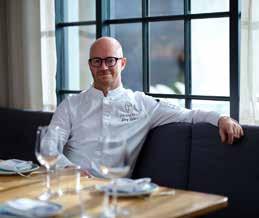
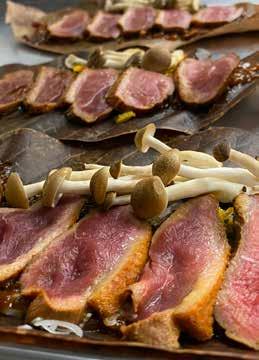



“It is by far the best way to experience Hai Noon, especially for first-time guests,” says Kuni Fukuda, Chef Nobuo’s son and the restaurant’s general manager.
Hai Noon’s ultimate showcase is the Japanese tradition of omakase, offered two Thursdays each month. Parties of four maximum must reserve at least two weeks in advance for this unique experience in which Chef Nobuo personally crafts and narrates a stunning selection of dishes. Each omakase night is unique, and ranges in price from $225 to $250 per person.
hainoonaz.com
Thai food is extremely popular, but American food enthusiasts often see the same wellknown items on the menus of restaurants in the U.S. James Beard Award semifinalist nominees Alex and Yokata “Sunny” Martin have taken what began in 2018 as a pop-up restaurant in their backyard to two brickand-mortar restaurants in Phoenix: Lom Wong and Mr. Baan’s Bar and Mookata, serving food and drinks that honor the lesser-known gustatory traditions of Thailand’s people and culture.
The culinary couple met while Alex was living and studying in Thailand. They connected over food and a mutual desire to communicate their small Thai village experiences, where family and friends shared their techniques, regional ingredients and most treasured traditions.
“We built our concept on sincerity,” Alex says. “That’s the only way we would do anything. We are sincere to our concepts, recipes and vision.”
Alex notes that there are more than 70 ethnicities in Thailand, and culinary arts are a way to preserve the uniqueness of indigenous communities and ethnic minorities while building connections with others. Sunny is from the Lanna culture, and the two highlight her own recipes as well as those from the Moklen
community, known for its seafood-centric, spicy, no-waste cooking.
A meal at Lom Wong is like visiting a Thai home, with a “punk rock fine dining” service style that is casual and communal but delivers bold, authentic flavors.
“It’s a service style that is unlike any European coursing,” Alex explains. “We don’t bend on our recipes or on how we bring out the courses because we want to protect the experience. Everything is meant to be shared, and each dish is part of a whole; it’s not meant to be one at a time. The flavors wouldn’t make sense if we served it one at a time.”
Must-tries include yam mamuang boran (green mango salad), gai tawt won pen (fried chicken) and ae kan khlak ti (Moklen sea bass curry). Adventurous diners should opt for the “arai kodai,” which means “I’m down for whatever” — a phrase that Alex used when wandering through restaurants on the far outskirts of Bangkok with an empty belly and a Thai-to-English dictionary that was useless for what the places were serving.
“Guests can note dietary restrictions and spice tolerance, but we will cook a meal that pushes you a little bit,” Alex adds. “You’ll realize it’s fine, and we will also give you dishes that will cool your palate.”
At neighboring Mr. Baan’s Bar and Mookata, Sunny and Alex serve refreshing Thai-inspired drinks alongside charcoalgrilled skewers and a late-night menu featuring items like Thai-style hot dogs. The star of the show is the mookata tabletop grill ($59 per person), which has a domed center for cooking meats and a moat of pork broth for simmering vegetables, noodles and tofu — a rare find in the U.S.
Whether you opt for Lom Wong or Mr. Baan’s Bar and Mookata, you are sure to taste and learn about a side of Thailand you might never otherwise experience.
lomwongaz.com mrbaans.com


Calabrian-born chef Rocco Pezzano and his family have a fitting tagline for their restaurant, Sfizio: “Eat like you’re in Italy, without the jet lag.” Diners have happily taken on that challenge, enjoying Pezzano’s family recipes and hospitality. The word “sfizio” itself means “the thing that satisfies your craving.”
If your cravings are for fresh pasta like short rib rigatoni orni, frutti di mare with mussels, clams, calamari, shrimp and a light spicy red sauce, you’ve found the right place. Perhaps you envision tucking into a comforting chicken Parmigiana or pan-seared pork tenderloin pizzaiola or indulging in a big slice of stone-fired pizza topped with white sauce, prosciutto, arugula, shaved Parmesan, ricotta and mozzarella — Sfizio has all that and more.
Pezzano keeps the menu short and manageable, changing specials every two to three months to fit the seasons and what is available. This summer, he plans to offer more wine tastings in which vintages from different regions will be paired with the food of those regions in three-course menus.
Also on the menu is an invention of Pezzano’s own making: sfizini, which comes from a childhood memory.
“My mother cooked in the morning,” he recalls. “She was always making a sauce while we played outside. She would hollow out a little piece of bread and stuff in some meat, sauce, a meatball or some chicken. Sfizini is a rendering of that memory. We serve a lunch portion with a choice of two fillings, with a salad alongside.”
Pezzano moved to the U.S. at age 25. In his years of cooking away from home, he longed for his southern Italian hometown “in the toe of the boot” and his mother’s cooking. To this day, her food is the benchmark against which he measures everything he serves.
“I have a soft spot for the south of Italy,” Pezzano says. “My main goal is to get the best ingredients. Italian food is the search to find the best ingredients — San Marzano tomatoes from Italy, flour from the south of Italy, some of our cheeses. We make our own mozzarella. We make all our pasta by hand — the gnocchi, everything. We make our own breads and pizza dough. It’s more work, but at the end of the day, it’s using the best ingredients. The simplicity is what makes Italian food really good.”
The hard work of Pezzano and his family has paid off in rave reviews from customers. He credits his wife and two children with always pitching in and helping him keep business humming along.
“People like that we are a scratch kitchen and a family business,” Pezzano says. “They are shying away from corporations. I’m here with my wife and kids. Customers like the contact and the fact that we are here as a family. We try to make everyone comfortable like they’re in our home. We take care of everyone directly. My family has been a big help. Sometimes a restaurant can take a family apart, but we got closer. We are united.”
sfizioitaliano.com
Anthem’s diverse culinary scene offers a taste of global flavors without leaving the neighborhood. From Asian fusion to Mediterranean delights, here’s a sampling of international cuisine right in our backyard:
Enjoy a slice of Italy with handtossed pizzas and homemade pasta, embodying the rustic, family-style dining traditions of Italian cuisine. giosanthem.com
Mr. Gyros
Indulge in classic Greek street food such as gyros and souvlaki, representing the casual, flavorful dining culture of Greece. mrgyrosanthem.com
Discover the bold, harmonious flavors of Thai cuisine with dishes like pad thai and green curry, showcasing the balance of sweet, sour, salty and spicy in Thai cooking. 623-551-6676
Savor authentic Chinese dishes, such as Peking duck and dim sum, showcasing the rich flavors and techniques of traditional Chinese cuisine. shanghaiclubonline.com
Experience the artistry of Japanese cuisine with fresh sushi rolls and sashimi, highlighting the importance of quality ingredients and presentation in Japanese culture. trapperssushi.com

Writer and Photographer Francine Coles
In a nod to my love of Middle Eastern food, I wanted to share this amazing paprikaroasted carrot hummus! The vibrant color and smoked paprika flavor will make you want to serve it often! It’s very similar to a traditional hummus in that you puree chickpeas, garlic, tahini, olive oil and lemon juice, but it gets an added zing when you roast carrots that have been seasoned with smoked paprika and puree them with the rest of the ingredients. Give this recipe a try when you’re in the mood for something less traditional!
Serves: 8
For the roasted carrots:
1 pound carrots, peeled and sliced 1/2-inch thick
1 tablespoon smoked paprika
Olive oil
Kosher salt
For the hummus:
1/4 cup ice-cold water, plus more if needed
One 15.5-ounce can chickpeas (no salt added), rinsed and drained
2 garlic cloves, roughly chopped
1/2 cup tahini
2 tablespoons olive oil
2 teaspoons lemon zest
2 tablespoons lemon juice
1 1/4 teaspoons kosher salt
For garnish:
1 tablespoon sesame seeds
1 tablespoon fresh dill
1 tablespoon chopped fresh chives
Flaky sea salt
Warm pita or pita chips, for serving
Directions:
Preheat the oven to 425 F. Line a sheet pan with parchment paper. Place the sliced carrots onto the sheet pan. Add the smoked paprika, a generous drizzle of olive oil, and a good pinch of salt. Toss to coat. Spread the carrots into an even layer. Roast for 30–35 minutes, or until tender. Let cool for about 10 minutes.
Add the water, roasted carrots, chickpeas, garlic, tahini, olive oil, lemon zest, lemon juice and salt to a high-powered blender or food processor. Blend until smooth and creamy, using a spatula to scrape down the sides of the blender a couple of times. If needed, add a little more water to help everything combine. Taste and add more salt if desired.
Plate the hummus with the sesame seeds, dill, chives, a pinch of flaky sea salt and a drizzle of olive oil over top. Serve with warm pita or pita chips alongside.
thefancypantskitchen.com




